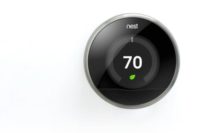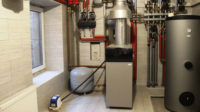
CEO Tony Fadell with the Nest
Learning Thermostat. Photo courtesy of Nest Labs
I was about two-thirds of the way through my reading of “Steve Jobs,” the new Walter Isaacson biography, when news of the Nest thermostat arrived. It
came in from a few dozen news sources that I watch, and also by email from a bunch of industry friends. All of this happened in an hour because that is the power of Apple.
Tony Fadell, one of the guys behind the Nest thermostat, is also the guy who engineered the iPod and helped change the music business forever. He appears in the Isaacson book, but I had never heard of him before that. Keep eyes on this guy.
We all have thermostats in our homes and offices, and we probably don’t give these commonplace controls much thought. We know the companies who are prominent in this field. Some of these companies have made wonderful advances in recent years. Modern thermostats can talk to building-management systems. You can even access some with your computer or smartphone. But along comes the Nest thermostat and the news media goes gaga over how it looks, and it does look nice. But the headlines scream, “Finally, a cure for the ugly thermostat!” As if all thermostats are ugly, except for this one.
That’s the power of Apple sauce. Steve Jobs was a genius, but I learned in the Isaacson book that he was also odd. He thought his vegan diet meant he didn’t have to use deodorant or bathe regularly, so he had horrible B.O. Oh, and he liked to soak his feet in toilet bowls.What if Apple made toilet bowls?
But, he was a genius and he certainly changed our lives. He gave us the Mac, the iPod, iPhone, iPad, iTunes, iCloud and Pixar. He hired Fadell along the way, and when Fadell left Apple, he took with him some of that Apple marketing magic. If you Google (sorry, Apple) the Nest thermostat you will see for yourself that it’s very stylish. It looks like a roundish iPhone.
The website explains that all you have to do is turn the dial to set Nest and then let it learn your ways. Nest uses a motion detector (which they don’t tell you) to memorize your habits and then it adjusts the temperature accordingly. A green leaf (which tilts in the same direction as the leaf in the Apple logo) appears to let you know you are now being green. And isn’t that wonderful?
You can set Nest with an iPhone/iPad app, of course, and you’ll be able to purchase it at Best Buy as soon as they make some more. By the way, it costs more than an iPhone, and within a week, Nest folks had to shut down their online store because they were completely sold out for months and months ahead.
Which should give you something to think about. I listened to some contractor and engineer friends discuss Nest and they mentioned that it has no way of sensing mean radiant temperature or the temperature of a radiant slab, so it’s probably for ordinary residential use. Which made me think of how many residences there are in the U.S.
And did I mention that they were all sold out? Another comment was that for that price, they should throw in an internal iPod and speaker so all you have to do is walk into the room and clap your hands to have the disco lights and Donna Summer come on.
And isn’t it funny how we make fun of anything that’s different?
I remember the week the iPad arrived. Bill Gates made fun of it and some in the media reported that geeks were pointing out that the name sounded like a feminine-hygiene product. This didn’t stop Apple from selling a gazillion iPads within the first year.
I read the reviews and didn’t think I needed one. But then my niece showed up one day and handed me hers to play with.
I bought mine the next day.
The new world order
I wonder how Nest will get along with an old steam system, and whether people with old steam systems will even be interested in it. I wonder how Nest will deal with old houses and whether the owners of those houses will expect miracles from this attractive device.On their website, Nest folks link to a YouTube video, which shows you how to install it. You can hire a certified professional to install it, if you’d rather. I can’t find any of those through their ZIP-code search, but the video tells me it’s easy to do myself. All I have to do is open the cover of my current thermostat, use my iPhone to take a photo of the wires and then email that photo to them. They’ll tell me what to do next.
Would you have a customer do that?
Their installation instructions are wellwritten. They begin with: “If you’ve ever installed a power outlet or an overhead lighting fixture - if you know how to shut off your circuit breakers and strip a wire - you’ll be more than comfortable installing Nest. Some installations are simple and take just 10 minutes, using only the Nest screwdriver. You might need needle-nose pliers or a power drill or wire strippers, depending on your existing installation. You also might want to patch and paint your wall or apply wallpaper to a trim plate. Take a few minutes to read through the instructions and to inspect your existing thermostat.”
Not bad, eh? It’s like they’re standing next to you. And they even give you that Nest screwdriver, which, like an iPhone, is very pretty.
I don’t know if Nest will give other thermostat manufacturers a run for their money, but I think it’s the instant attention this device received that makes this such a compelling story. People in this business often talk about how most consumers don’t care about what we have to offer because they can’t show it to the neighbors. That’s not the case with Nest. This is something they’ll show the neighbors, and all because of the news coverage. Neighbors will look at it and say, “Hey, it’s just like Apple!”
We’re living in that sort of world now. We pay more attention to “Dancing With the Stars” than we do to heat-loss calculations. Nest made the Apple connection and the press ran with it. Nest chose to sell though Best Buy instead of through you because you don’t sell iPhones, iPads or iPods.
Nest is saying that there’s no need for the traditional means of distribution, and there’s really no need for the traditional installer.
One of the themes that fl ows through the Isaacson biography of Steve Jobs is how Jobs believed in closed systems, meaning the merging of hardware and software to make the consumer’s experience simple and seamless. Jobs’ opposite is Gates and Microsoft. Gates believes in open systems, where Microsoft writes the software, and anyone can build the hardware.
Microsoft prevailed at first, but Apple came roaring back with its closed approach to things. That’s what appeals to so many consumers these days.
We’ve traditionally cobbled our heating systems together - a burner from this company, a boiler from that company, controls from all over the map.
But what if one company came up with a total, great-looking, captivating package and sold it like a Mac?
What if Apple decided to make a boiler, or a complete heating system?
They most likely won’t, but what if someone else did, using the Apple approach? Would that change our industry?
If you’re shaking your head and thinking I’m foolish, keep in mind that Nest sold out in a matter of days and had to shut down its online store.
Tom Friedman, in his latest book, “That Used to Be Us: How America Fell Behind in the World It Invented and How We Can Come Back,” writes, “In 2005, Facebook didn’t exist for most people, ‘Twitter’ was still a sound, the ‘cloud’ was something in the sky, ‘3G’ was a parking space, ‘applications’ were what you sent to colleges, and ‘Skype’ was a typo.”
What if Tony Fadell makes a furnace?




